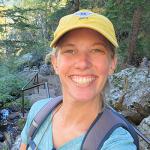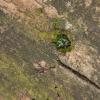“You are the only person who will advocate for your farm. Your land needs your voice and actions to care for it.”
- Ruth Rabinowitz, Iowa farmer
When it comes to thinking about conservation within the Iowa landscape it’s important to make sure everyone has a seat at the table. Roughly 97 percent of the state is privately owned and over 85 percent of that land is considered farmland. Iowa is known for its corn and soybean production as well as pork and poultry—and nearly half of the agricultural land in the state is owned or co-owned by women, such as Ruth Rabinowitz.

Ruth Rabinowitz is an Iowa farmer with a commitment to protecting the land. Since inheriting farmland she has taken steps to reduce soil erosion and increase habitat for wildlife. Here she is inspecting prairie growing in a field edge buffer. (Photo courtesy of Ruth Rabinowitz.)
Ruth did not grow up in Iowa. She was born in Michigan, raised in Arizona, and spent part of her adult life in California, but she has a long connection with the land in the state where she now lives. Her father invested in agricultural land in Iowa and South Dakota and as a child Ruth made regular trips to the Midwest, so much so that the Iowa State Fair became a staple in family life. After his passing, her father’s land assets and responsibilities fell into the hands of Ruth and her sister, Shauna. It wasn’t until Ruth became a farm manager that it became clear the farms her father had owned were in rough shape. Soil erosion was evident on most of the farms, and this alarmed Ruth a great deal. Adding to the challenges for Ruth was the fact that she was living in the Bay Area of California for most of the time. Managing farms remotely is no easy task, even when the land is in good condition.
Nearly 13 percent of Iowa’s agriculture land is owned by a non-operating landowner who lives out of state. The distance between California and Iowa did not allow Ruth to be present for all the farming activities (planting, growing, and harvest), compounded by being responsible for a number of small farms in south central and northeast Iowa, and northeast South Dakota. Nonetheless, she and her sister immediately got to work to improve their valuable land. Conservation practices were considered out of a deep concern about soil health, water quality, and wildlife. Being able to successfully balance conservation while also maintaining profitability was critical, too. Ruth had run her own photography business for over twenty years before becoming the family’s farm manager in 2013. Farming was now her main source of income.
Conservation is essential to Ruth. The next generation is something Ruth spends a lot of time thinking about. She feels a calling to make positive changes to the land her father worked hard to provide for his children. It’s important for her to remember to look beyond her own lifetime. She grew up with a large garden and had her own garden in California, but she knew she had much to learn in terms of sustainable agriculture. She knew she would need assistance in trying to make her goals reality. Ruth partnered with a number of different conservation experts to acquire technical assistance for a variety of projects. The USDA Natural Resource Conservation Service (NRCS) has been her primary technical resource over the years in Iowa and South Dakota, and she also asked Xerces Society for pollinator conservation guidance. Other organizations that have provided technical and financial assistance include Ducks Unlimited, Environmental Defense Fund, Pheasants Forever, and Practical Farmers of Iowa.

Xerces Society conservation staff have collaborated on the creation and management of habitat for pollinators and other beneficial insects. The lush growth of flowers in this pollinator prairie comes in the spring of its fourth year, following a prescribed fire to control weeds. (Photo: Xerces Society / Sarah Nizzi.)
Ruth considers the topsoil to be the skin of the earth, and it is a high priority while she walks her farms. Cover crops and no-till practices have been added to some of the farms, but she admits this has been a slow process. She also has implemented twenty-five grassed waterways designed to capture and move rainwater across a field to reduce erosion and keep sediment from being delivered to lakes, streams, or rivers. Habitat and wildlife projects include creating two one-acre ponds, planting field edges with native vegetation as conservation buffers, and managing small and large forested areas to stimulate the growth of native species. One of the Iowa farms is home to a seven-acre project to restore an oxbow wetland, a curving meander that no longer is connected to the water flow of a river. These ecosystems provide important habitat for aquatic species and other wildlife. Ruth is enrolled in eighteen different Conservation Reserve Program (CRP) contracts, a sign of her commitment to protecting the land.
In 2017 Ruth began working with the Xerces Society to create pollinator habitat with the help of an Iowa Conservation Innovation Grant through NRCS. We converted three-fourths of an acre of idle ground to a diverse native prairie mix. The previous vegetation was very low quality and predominantly the non-native smooth brome grass. The site prep was done by burning in the fall of 2017 and then sprayed once vegetation began to green up again. The site was sprayed again the following spring in 2018 and then planted. This year the prairie is in its fourth growing season and experienced its first prescribed fire this past spring. Although the site prep and planting took place before my time with Xerces, it has been fun to inherit this project and watch the progression of the planting. I have monitored this planting since late summer of 2018. Every year it steadily improves. Ruth and I have walked the area together a few times now and she greatly appreciates learning more about the native plants present and what she should be looking out for in terms of management.
Education and outreach is also meaningful to Ruth. She is more than willing to share her story to inspire and help others. She has held a number of tours on her property to discuss conservation practices. She has partnered with the Iowa Farmers Union and the Environmental Defense Fund to host field days. She also graciously allowed her Xerces pollinator planting to be part of a Women Food and Agriculture Network (WFAN) workshop in the summer of 2018. Xerces and WFAN hosted over twenty women landowners and farmers interested in pollinator habitat. During the event, Ruth shared her experience of planting pollinator habitat and I spoke about the early establishment period of a pollinator planting.

Part of Ruth’s commitment to conservation is getting more people involved. She has hosted several field days and other learning events on the farms she manages. This photo shows her (in red, with microphone) speaking at a Women Food and Agriculture Network (WFAN) workshop in the summer of 2018. The author (gray shirt, facing camera) also spoke during the event. (Photo: Xerces Society / Jennifer Hopwood.)
I remain in regular contact with Ruth and spoke with her while thinking about this article. I asked her several questions, but there are some responses that I think are more significant. The following answers are in Ruth’s own words.
What has been most rewarding about installing conservation practices on your agriculture land?
“Now that I am living on my farm in Madison County Iowa, I am surprised and delighted that there is so much wildlife present on this corn/soybean ground. There is enough water, ponds, creeks, and small forests to attract deer, pheasants, coyotes, and owls, and [when] I hear their calls, my heart skips a beat in joy. I can see and enjoy the fruits of my labor that took the last ten years to do and yet I feel I am still at the beginning.”
Do you have any advice for conservation curious folks who own agriculture land?
“Start with NRCS at the USDA Service Center. Meet your [county] District Conservationist (DC) and walk and/or drive your farm with USDA staff. I also join every nonprofit conservation-minded group in my area and Zoom regularly with their trainings, boot camps, and sessions. There is so much to learn and understand in the world of farming and it’s constantly evolving and changing.
Lastly, do you have advice for women landowners?
“Walk your farm or get in an off-road vehicle and see every acre you can. I have found dump sites, trespassing, deep [soil] erosion, and more that no one would have ever told me about. You are the only person who will advocate for your farm. Your land needs your voice and actions to care for it. As a landowner you are the caretaker of the land. It’s your responsibility to make sure your land is being treated well. No-till and cover crops are good to start with. Use a written farm lease that details your conservation goals for your farm and require annual reporting from your operator. There is a lot of heavy lifting involved in being a conservation-minded landowner. Taking it all in one step at a time is key to not feeling overwhelmed.”

Spiderwort (Tradescantia) blooming in the pollinator prairie the spring after a prescribed fire to control weeds. (Photo: Xerces Society / Sarah Nizzi.)
In order to move the needle in terms of increasing conversation and increasing interest in conservation we must share stories of people making a difference. Sharing our stories and passion for prairies, bumble bees, songbirds, soils, or trees is vital. Exposing our friends and family to nature is also critical. A personal connection to nature can go a long way in sparking inspiration and conservation action. All living things are connected to one another and that includes us. But no single living thing can make a difference on its own. Native bees cannot pollinate native flowering plants if there are none. Freshwater mussels cannot help filter water if they are being poisoned by toxins. We humans must do our part to ensure ecosystems can thrive well into the future. I greatly appreciate Ruth for being willing to share her story and caring for the land. As someone who was born and raised in Iowa, I am delighted to have leaders like Ruth calling my home state their home.
Further Reading
Learn more about the Xerces Society’s Pollinator Conservation Program.
Find out how you can help Bring Back the Pollinators.
Locate your local USDA Natural Resource Conservation Service office to get advice and assistance with conservation work.
Download detailed guidance documents and plant information from our Pollinator Conservation Resource Center.




